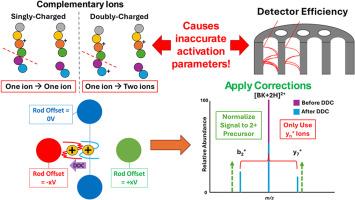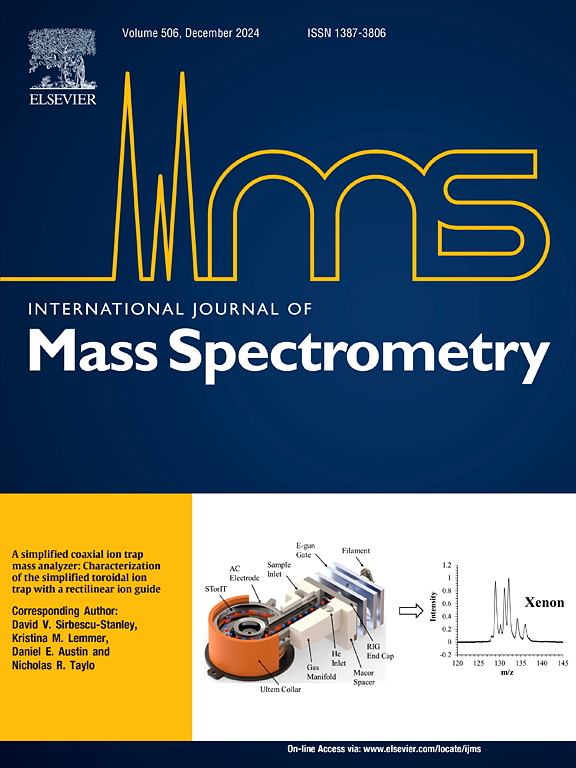Arrhenius parameters of singly- and doubly-protonated bradykinin measured via dipolar DC kinetics on a quadrupole/time-of-flight platform
IF 1.7
3区 化学
Q3 PHYSICS, ATOMIC, MOLECULAR & CHEMICAL
引用次数: 0
Abstract
Gas-phase fragmentation has long been used to obtain ion structure information, thereby significantly expanding the information that can be obtained via mass spectrometry. Experimental approaches for obtaining quantitative measures of the energies and entropies of unimolecular reactions of ions can be valuable for providing insights into mechanistic aspects of ion fragmentation. Such measurements can be particularly challenging for large polyatomic ions. Approaches that vary the temperatures of ions in a known way can be used to determine Arrhenius or Eyring parameters. However, such approaches require careful variation of the temperature of the vacuum system. Ion trap collisional activation provides another approach to varying ion temperatures provided the experimental conditions used can be connected with an effective ion temperature. Tolmachev et al. have described such a model using dipolar DC as a means for inducing controlled rf-heating. We have evaluated this model using the well-studied protonated leucine enkephalin as a thermometer ion and found that, with a few adjustments, the model is useful in establishing effective temperatures to associate with DDC kinetics measurements. In this work, we evaluate the adjusted model using another singly-protonated thermometer ion, protonated bradykinin, and extended the approach to doubly-protonated bradykinin. The latter ion allowed us to determine how to conduct ion survivor measurements using a channelplate detector under the scenario of a doubly-charged precursor giving rise to complementary pairs of singly charged products.

在四极杆/飞行时间平台上通过偶极直流动力学测量单质子化和双质子化缓激肽的Arrhenius参数
长期以来,气相破碎一直被用于获取离子结构信息,从而大大扩展了通过质谱法可以获得的信息。获得离子单分子反应的能量和熵的定量测量的实验方法对于提供离子碎裂的机制方面的见解是有价值的。这种测量对于大的多原子离子来说尤其具有挑战性。以已知方式改变离子温度的方法可用于确定Arrhenius或Eyring参数。然而,这种方法需要小心地改变真空系统的温度。离子阱碰撞激活提供了另一种改变离子温度的方法,前提是所使用的实验条件可以与有效离子温度联系起来。Tolmachev等人描述了这样一个模型,使用偶极直流电作为诱导受控射频加热的手段。我们使用质子化亮氨酸脑啡肽作为温度计离子对该模型进行了评估,并发现,经过一些调整,该模型可用于建立与DDC动力学测量相关的有效温度。在这项工作中,我们使用另一种单质子化的温度计离子,质子化的缓激肽来评估调整后的模型,并将该方法扩展到双质子化的缓激肽。后一种离子使我们能够确定如何在双电荷前驱体产生互补对的单电荷产物的情况下使用通道板探测器进行离子存活量测量。
本文章由计算机程序翻译,如有差异,请以英文原文为准。
求助全文
约1分钟内获得全文
求助全文
来源期刊
CiteScore
3.60
自引率
5.60%
发文量
145
审稿时长
71 days
期刊介绍:
The journal invites papers that advance the field of mass spectrometry by exploring fundamental aspects of ion processes using both the experimental and theoretical approaches, developing new instrumentation and experimental strategies for chemical analysis using mass spectrometry, developing new computational strategies for data interpretation and integration, reporting new applications of mass spectrometry and hyphenated techniques in biology, chemistry, geology, and physics.
Papers, in which standard mass spectrometry techniques are used for analysis will not be considered.
IJMS publishes full-length articles, short communications, reviews, and feature articles including young scientist features.

 求助内容:
求助内容: 应助结果提醒方式:
应助结果提醒方式:


